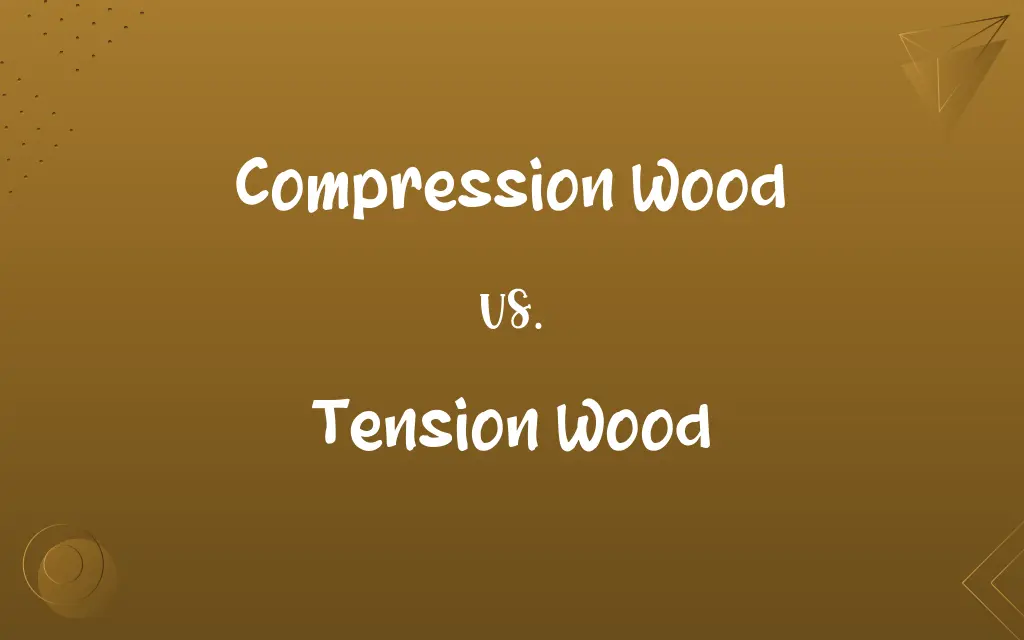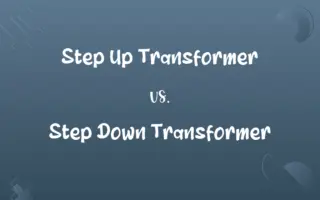Compression Wood vs. Tension Wood: Know the Difference

By Shumaila Saeed || Updated on December 25, 2023
Compression Wood is a denser, abnormal growth in softwood trees under mechanical stress, whereas Tension Wood is a less dense, fibrous growth in hardwoods under similar stress.

Key Differences
Compression Wood forms on the lower side of branches and leaning stems in conifers, characterized by its high density and darker color, due to stress or gravity. Tension Wood, in contrast, develops on the upper side of hardwood branches and leaning stems, featuring gelatinous fibers and lighter color, as a response to similar mechanical forces.
Shumaila Saeed
Dec 15, 2023
The cellular structure of Compression Wood differs significantly from normal wood, with more rounded and less organized cells, leading to its increased density and mechanical strength. Tension Wood's cells, however, are more elongated and contain a specific type of cellulose, giving it unique flexibility and strength properties.
Shumaila Saeed
Dec 15, 2023
In terms of chemical composition, Compression Wood has higher lignin and lower cellulose content compared to normal wood. Tension Wood, on the other hand, has higher cellulose content, especially a type called G-layer, which contributes to its unique tensile strength.
Shumaila Saeed
Dec 15, 2023
Compression Wood can cause issues in timber quality, leading to warping and reduced wood value. Tension Wood also affects timber quality but is less problematic than Compression Wood, as it causes less distortion.
Shumaila Saeed
Dec 15, 2023
Both Compression Wood and Tension Wood are adaptive responses of trees to mechanical stress or damage. However, Compression Wood is more common in gymnosperms (softwoods), while Tension Wood predominantly occurs in angiosperms (hardwoods).
Shumaila Saeed
Dec 15, 2023
ADVERTISEMENT
Comparison Chart
Tree Type
Common in softwoods (gymnosperms)
Found in hardwoods (angiosperms)
Shumaila Saeed
Dec 15, 2023
Location of Growth
Lower side of branches/leaning stems
Upper side of branches/leaning stems
Shumaila Saeed
Dec 15, 2023
Cellular Structure
Rounded, disorganized cells
Elongated cells with specialized cellulose
Shumaila Saeed
Dec 15, 2023
Impact on Timber
Causes warping, reduces quality
Less distortion, affects quality differently
Shumaila Saeed
Dec 15, 2023
ADVERTISEMENT
Compression Wood and Tension Wood Definitions
Compression Wood
It forms on the lower side of branches or leaning trunks in conifers.
The underside of the sloped branch showed signs of Compression Wood.
Shumaila Saeed
Dec 04, 2023
Tension Wood
Contains a special type of cellulose, giving it unique tensile strength.
The Tension Wood's strength was attributed to its unique cellulose composition.
Shumaila Saeed
Dec 04, 2023
Compression Wood
Known for causing warping and issues in timber processing.
The presence of Compression Wood in the logs led to challenges during milling.
Shumaila Saeed
Dec 04, 2023
Tension Wood
Tension Wood is less dense, with a high cellulose content.
The lighter, fibrous area in the wood sample was identified as Tension Wood.
Shumaila Saeed
Dec 04, 2023
Compression Wood
Compression Wood has a higher lignin content and is darker than normal wood.
The dark rings in the lumber were identified as Compression Wood.
Shumaila Saeed
Dec 04, 2023
ADVERTISEMENT
Tension Wood
An adaptive, fibrous growth in hardwoods responding to stress.
The oak tree's response to the leaning angle was the formation of Tension Wood.
Shumaila Saeed
Dec 04, 2023
Compression Wood
Compression Wood has a characteristic rounded cell structure.
Under the microscope, the Compression Wood's rounded cells were clearly visible.
Shumaila Saeed
Dec 04, 2023
Tension Wood
Develops on the upper side of hardwood branches and stems.
Tension Wood was evident on the upper part of the bent maple branch.
Shumaila Saeed
Dec 04, 2023
Compression Wood
Abnormal, dense growth in softwoods due to mechanical stress.
The leaning pine tree developed Compression Wood to maintain its stability.
Shumaila Saeed
Dec 04, 2023
Tension Wood
Affects timber quality differently, causing less distortion than Compression Wood.
While Tension Wood was present in the lumber, it did not affect its usability as much as Compression Wood.
Shumaila Saeed
Dec 04, 2023
Repeatedly Asked Queries
What characterizes Tension Wood?
It's a fibrous, less dense wood growth in hardwoods, formed in response to stress.
Shumaila Saeed
Dec 15, 2023
How does Compression Wood affect lumber quality?
It can cause warping and reduces the quality of timber.
Shumaila Saeed
Dec 15, 2023
What is Compression Wood?
It's a dense, abnormal wood growth in softwoods due to mechanical stress.
Shumaila Saeed
Dec 15, 2023
Where is Tension Wood typically found?
On the upper side of hardwood branches and stems.
Shumaila Saeed
Dec 15, 2023
Where does Compression Wood usually form?
On the lower side of branches and leaning stems in softwoods.
Shumaila Saeed
Dec 15, 2023
What causes the formation of Compression Wood?
Mechanical stress or gravity acting on softwood trees.
Shumaila Saeed
Dec 15, 2023
Is Compression Wood easy to identify?
Yes, due to its higher density and darker color.
Shumaila Saeed
Dec 15, 2023
What leads to the development of Tension Wood?
Similar stressors as Compression Wood, but in hardwood trees.
Shumaila Saeed
Dec 15, 2023
What about the chemical composition of Tension Wood?
It has a higher cellulose content, especially a special type called G-layer.
Shumaila Saeed
Dec 15, 2023
Can both types of wood be found in the same tree?
Generally, no. Compression Wood is in softwoods and Tension Wood in hardwoods.
Shumaila Saeed
Dec 15, 2023
What role does Tension Wood play in a tree's growth?
It helps the tree adapt to mechanical stress and maintain structural integrity.
Shumaila Saeed
Dec 15, 2023
Can Compression Wood be used in construction?
Its use is limited due to warping and quality issues.
Shumaila Saeed
Dec 15, 2023
Can Compression Wood be prevented?
Not entirely, as it's a natural response to environmental conditions.
Shumaila Saeed
Dec 15, 2023
Does Tension Wood impact timber quality?
Yes, but usually less severely than Compression Wood.
Shumaila Saeed
Dec 15, 2023
What is the main difference in the cellular structure of Compression Wood and Tension Wood?
Compression Wood has rounded cells, while Tension Wood has elongated cells with specialized cellulose.
Shumaila Saeed
Dec 15, 2023
How does Compression Wood affect tree growth?
It can lead to asymmetrical growth and stability issues in the tree.
Shumaila Saeed
Dec 15, 2023
Does Compression Wood have any unique chemical properties?
Yes, higher lignin and lower cellulose content.
Shumaila Saeed
Dec 15, 2023
Can the formation of Tension Wood be controlled?
Like Compression Wood, it's largely dependent on external stress factors.
Shumaila Saeed
Dec 15, 2023
Is Tension Wood suitable for woodworking?
It can be used, but with considerations for its unique properties.
Shumaila Saeed
Dec 15, 2023
Share this page
Link for your blog / website
HTML
Link to share via messenger
About Author
Written by
Shumaila SaeedShumaila Saeed, an expert content creator with 6 years of experience, specializes in distilling complex topics into easily digestible comparisons, shining a light on the nuances that both inform and educate readers with clarity and accuracy.


































































